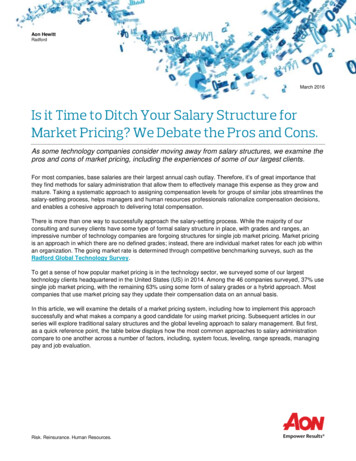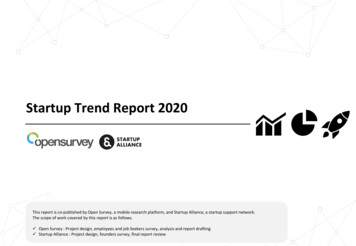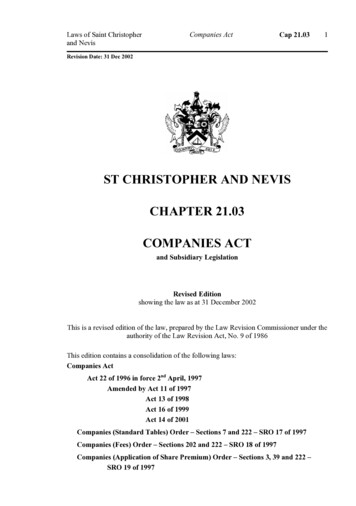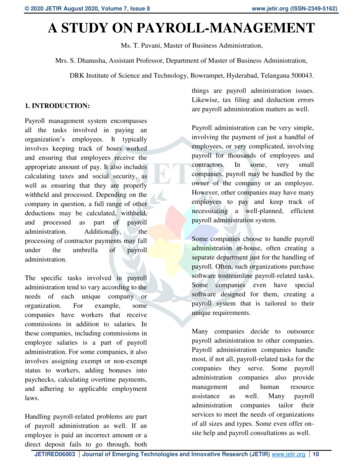
Transcription
Aon HewittRadfordMarch 2016As some technology companies consider moving away from salary structures, we examine thepros and cons of market pricing, including the experiences of some of our largest clients.For most companies, base salaries are their largest annual cash outlay. Therefore, it’s of great importance thatthey find methods for salary administration that allow them to effectively manage this expense as they grow andmature. Taking a systematic approach to assigning compensation levels for groups of similar jobs streamlines thesalary-setting process, helps managers and human resources professionals rationalize compensation decisions,and enables a cohesive approach to delivering total compensation.There is more than one way to successfully approach the salary-setting process. While the majority of ourconsulting and survey clients have some type of formal salary structure in place, with grades and ranges, animpressive number of technology companies are forgoing structures for single job market pricing. Market pricingis an approach in which there are no defined grades; instead, there are individual market rates for each job withinan organization. The going market rate is determined through competitive benchmarking surveys, such as theRadford Global Technology Survey.To get a sense of how popular market pricing is in the technology sector, we surveyed some of our largesttechnology clients headquartered in the United States (US) in 2014. Among the 46 companies surveyed, 37% usesingle job market pricing, with the remaining 63% using some form of salary grades or a hybrid approach. Mostcompanies that use market pricing say they update their compensation data on an annual basis.In this article, we will examine the details of a market pricing system, including how to implement this approachsuccessfully and what makes a company a good candidate for using market pricing. Subsequent articles in ourseries will explore traditional salary structures and the global leveling approach to salary management. But first,as a quick reference point, the table below displays how the most common approaches to salary administrationcompare to one another across a number of factors, including, system focus, leveling, range spreads, managingpay and job evaluation.Risk. Reinsurance. Human Resources.
Aon HewittRadfordSalary Administration Approaches and CharacteristicsSalary Structure ModelsDesignCharacteristicsMarket PricingFocusTraditionalGlobal LevelingExternalBalance between internaland externalPrimarily internal, with anexternal viewNumber of LevelsNo levels; rather each jobhas its own referencerangeMany grades (up to 20)Fewer grades (10-12)Range SpreadAnywhere from /- 5% to /- 20% around a marketdata point50%-60%60%-100%Managing PayUses guidelines tomanage pay around orwithin the rangeUses minimum, midpoint,maximum (or dividesgrades into thirds)Uses functional payrangesJob EvaluationUses market datasupported by job matchingUses market datasupported by whole jobslottingUses career levels to slotjobsHow Do You Market Price Jobs?At a basic level, market pricing jobs involves gathering market data for each job from a selected peer group anddetermining the low, median and high points of base salary. Unlike salary grades, which use data to create salaryranges around job levels and job families, market pricing targets specific pay for individual job titles. Whereassalary structures can result in ten or more grades with ranges, market pricing will often result in hundreds ofmarket reference guidelines— one for each job and geographic region.In order to create market reference points for each job, begin by matching your company’s jobs to like positions incompetitive compensation surveys. Most companies start with their job descriptions or interview line managers toconfirm their understanding of each job and then determine the “best fit” jobs in a survey. Job descriptions inRadford surveys summarize the primary responsibility of each job. In general, if your job content matches asurvey job by 75% or more, it can be considered a good match.Next, decide which group of companies best represents your competitive market for talent. For positions belowthe executive level, industry and geography factor most prominently into determining pay levels. The goal is toidentify a comparator group that is specific enough to have credibility within your company and robust enough toprovide solid external benchmark data. The final step in market pricing is to determine where to position yourcompany’s pay relative to the market data you collect. Although most companies will say they target medianIs it Time to Ditch Your Salary Structure for Market Pricing? We Debate the Pros and Cons.
Aon HewittRadfordmarket levels, there are valid arguments for aiming higher, or for holding fixed pay lower than the median. Thebar chart below shows the prevalence of pay positioning for technology companies across the globe.Target Pay Positioning for Base Salary25th Percentile90.0%80.0%79.3%50th Percentile75th utivesManagementTechnical ProfessionalNon-TechnicalProfessionalSource: Radford Global Technology Survey, Workforce Trends Report: Q1 2015Why Choose Market Pricing?Market pricing isn’t right for everyone. Before deciding if it makes sense to adopt a marketing pricing approach atyour company, first consider the pros and cons listed below:Benefits:Challenges: Arguably a more “precise” approach compared togrouping multiple jobs into broader grades The maintenance of numerous reference pointsyear-over-year, particularly for companies thatuse multiple salary surveys, is time-consuming Pinpointing specific pay levels provides greaterflexibility to respond to changing markets (e.g.,hot skills related to certain jobs, local labormarket supply/demand pressures) Puts excessive emphasis on each survey datapoint to represent “the market,” sometimesignoring that survey data may be more or lessrobust from market to market Internal equity or “pay compression” issues areless likely if you are managing to precise marketprices updated annually Requires all jobs to have a benchmark match,often resulting in forced matchesIs it Time to Ditch Your Salary Structure for Market Pricing? We Debate the Pros and Cons.
Aon HewittRadford A job-by-job salary target is relatively simple toexplain to managers and employees Can create internal inequities in pay throughoutcareer ladder progressions Not conducive to a complete system tying base,bonus, and LTIWhile market pricing is arguably more precise, it can be time-consuming to manage and often requires moreinternal resources. The approach has been lauded for its fairness, but at the same time, some managers worrythat it puts too much emphasis on pay. Individual job market pricing also doesn’t lend itself to the consistentdelivery of incentive pay levels, where equity grants and bonus targets are linked to salary grade.Client Case StudyLarge Hardware Company Debates the Merits of Market PricingThis US-based multinational company has used different pay-setting approaches throughout its history. Whilethey currently use market pricing, the firm is contemplating adopting a more structured approach. With continueddiversification of their business, the company has used this opportunity to discuss whether they can implement asystem that will still yield accurate and current pay data, while being less labor intensive.The technical foundation upon which the company was founded has fostered a workforce that values precisionand accuracy. These values align well with a market pricing model. However, as the business has diversified, thecompany’s job structure has expanded, making market pricing a far more involved process than it once was. Saysone compensation leader: “It’s just too much work to do, and, at a certain level, it does not present the same levelof accuracy we thought it would give us.” Furthermore, the client is finding limited external data sources in someof its regions, making its singular pricing strategy more difficult.The company says its legacy of market pricing has created a culture where managers sometimes overthinkmarket guidance. And managers can become too focused on compensation precision.Furthermore, as more technology sector companies also contemplate changes to their performance ratingsystems— often to focus less on the quantitative and more on the qualitative— our client says it’s logical thatcompensation reviews would move in a similar direction.So where does the market pricing approach work best? For companies in highly competitive, fast-moving talentmarkets, like we see in much of the technology space, this level of specificity often resonates with managers.They can feel confident their job offers are exactly pegged to the market and have a lower likelihood of runninginto pay compression, which is where new hires are paid at or above the levels of long-standing employees.Often, small or start-up companies use this approach for a few years but outgrow it when they reach 250 to 500employees and need something more comprehensive that links all compensation elements— base, bonus,equity— in a more comprehensive and easier-to-manage system.It should be noted that most companies with formal salary structures for their broad employee populations still usethe market pricing approach for sales jobs because the pay mix for sales positions is so different from other jobs,Is it Time to Ditch Your Salary Structure for Market Pricing? We Debate the Pros and Cons.
Aon HewittRadfordthey don’t logically fit into traditional salary structures. In addition to sales positions, many companies use marketpricing for legal jobs or other families that are outliers relative to the broad population, either from a pay levelstandpoint or from a pay movement point of view. For example, hot jobs where demand is high but there are notenough qualified people to fill the growing number of positions. In these cases, market pricing each individualposition renders more precise data for companies to recruit finite talent.While a market pricing approach creates customized and precise pay data for each individual job, it’s not withoutits challenges. Though the entire concept of market pricing is antithetical to structured systems, companies cantake steps to lay a solid foundation upon which market pricing can be optimized. Here are three things we believecompanies should do to ensure effective implementation:1. Dedicate resources.Market pricing is time consuming and if a company doesn’t have the resources to maintain and monitormarket data, the system breaks down and data can quickly become stale.2. Have a contingency plan.For positions where adequate market data cannot be found, compensation teams must identify internaljobs that can serve as a proxy or use alternative market data sources that will have credibility internally.3. Think about careers.Market pricing single jobs does not ensure logical salary progression within a given job family or acrossfunctions. In-family or lateral promotions require close attention to ensure appropriate pay progression ispossible. Certain jobs and locations will have limited market data no matter which external benchmarkingsource you use. In these cases, it’s important to consider alternative data points (see our article, The Art& Science of Benchmarking: What Happens When Pay Doesn't Progress?, for more information).Client Case StudyDiversified Tech Company Dedicates Resources to Market PricingThis multinational, diversified technology company has used a market pricing strategy for all of its job positionsover the past ten years. The pricing strategy gives managers confidence that the value they assign to their jobsaccurately reflects the market. The approach is easy to communicate to managers and appeals to the company’slarge population of technical employees who prefer the precision of market pricing.However, there are drawbacks. On its own, market pricing can’t incorporate the internal value or importance of aparticular position that might not be reflected in the broader marketplace. Non-traditional or emerging job positionsare also harder to assign a value to; meanwhile, the cost of market pricing each job can’t be ignored. Still, ourclient says they would only contemplate a move toward a more structured pay approach if the change would stillresult in market-aligned competitive pay that all parties feel is fair.The firm imparts the following advice to companies contemplating a market pricing strategy: (1) Clearly defineyour objectives and pay philosophy; (2) understand your organization, including its size, job levels and positions;and (3) evaluate the pros and cons of market pricing for your organization, including the cost of implementing thepricing system compared with your current system.Is it Time to Ditch Your Salary Structure for Market Pricing? We Debate the Pros and Cons.
Aon HewittRadfordNext StepsWhen it comes down to it, the decision to use competitive salary data to design your compensation system is aquestion that is deeply dependent on your company’s pay philosophy, workforce characteristics and internalresources. Your human resources and compensation managers should start the decision making process byasking questions like: Is pay competitiveness to the external market more important to us than internal equity? Do we have a technically strong compensation team with the bandwidth to update market pricing at leastannually? Can our compensation administration system support hundreds— if not thousands— of market referencepoints easily?If the answer is yes to some or all of these questions, then market pricing jobs could be an approach that workswell for your company.While we see a slight preference in the marketplace right now for formal salary structures, there are many leadingcompanies that find market pricing to be the right approach for their business. We believe the market place willalways allow room for multiple approaches to salary administration.Stay tuned for the second part in our series on salary administration that will focus on the use of traditional salarystructures.To speak with a member of our compensation consulting group about your company’s approach to salaryadministration, please write to consulting@radford.com.Is it Time to Ditch Your Salary Structure for Market Pricing? We Debate the Pros and Cons.
Aon HewittRadfordAuthor Contact InformationBrooke GreenAssociate Partner, RadfordAon Hewitt 1.415.486.6911brooke.green@radford.comAbout RadfordRadford delivers compensation data and advice to technology and life sciences companies. We empower theworld's most innovative organizations, at every stage of development, to hire, engage and retain the top talentthey need to do amazing things. Today, our surveys provide in-depth compensation insights in more than 80countries to over 2,850 participating organizations, and our consultants work with hundreds of firms annually todesign rewards programs for boards of directors, executives, employees and sales professionals. Radford is partof Aon Hewitt, a business unit of Aon plc (NYSE: AON). For more information on Radford, please visitradford.com.About Aon HewittAon Hewitt empowers organizations and individuals to secure a better future through innovative talent, retirementand health solutions. We advise, design and execute a wide range of solutions that enable clients to cultivatetalent to drive organizational and personal performance and growth, navigate retirement risk while providing newlevels of financial security, and redefine health solutions for greater choice, affordability and wellness. Aon Hewittis the global leader in human resource solutions, with over 30,000 professionals in 90 countries serving more than20,000 clients worldwide. For more information on Aon Hewitt, please visit aonhewitt.com.This article provides general information for reference purposes only. Readers should not use this article as a replacement for legal,tax, accounting or consulting advice that is specific to the facts and circumstances of their business. We encourage readers to consultwith appropriate advisors before acting on any of the information contained in this article.The contents of this article may not be reused, reprinted or redistributed without the expressed written consent of Radford. To useinformation in this article, please write to our team. 2016 Aon plc. All rights reservedIs it Time to Ditch Your Salary Structure for Market Pricing? We Debate the Pros and Cons.
competitive compensation surveys. Most companies start with their job descriptions or interview line managers to confirm their understanding of each job and then determine the "best fit" jobs in a survey. Job descriptions in Radford surveys summarize the primary responsibility of each job. In general, if your job content matches a










